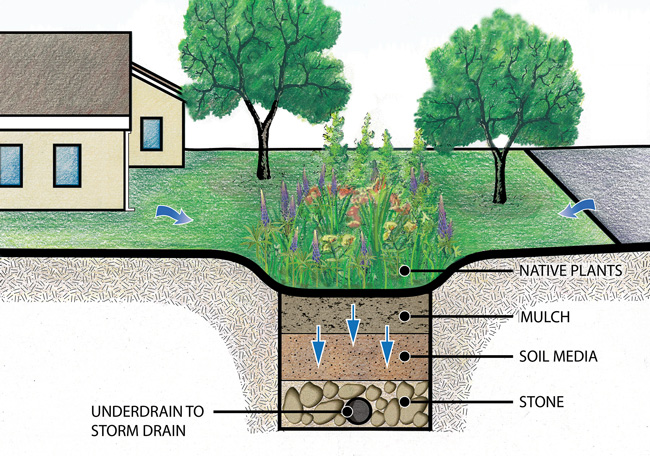
Protecting our environment, one stormwater practice at a time.
Bioretention Practices: Basins and Filters
Overview
Bioretention practices include filters and basins (rain gardens). Rainwater from our yards, rooftops, parking lots, sidewalks and roads collects in these facilities. They are planted depressions that filter stormwater, promote infiltration and reduce erosion potential and pollutants, thus improving water quality in our local streams and the Chesapeake Bay. They filter runoff through layers of native plants, mulch, soil media and stone. Due to their small size, they are often installed in recreational and residential areas, as well as parking lot islands.
How Bioretention Practices Work
 Bioretention filters are designed to provide water quality control and detention of storm water runoff from small storms. Bioretention filters have a perforated pipe (underdrain) within a stone layer that collects and directs the filtered stormwater to the storm drain system, allowing the facility to drain within 48 hours.
Bioretention filters are designed to provide water quality control and detention of storm water runoff from small storms. Bioretention filters have a perforated pipe (underdrain) within a stone layer that collects and directs the filtered stormwater to the storm drain system, allowing the facility to drain within 48 hours.
Bioretention basins are designed to provide water quality control and retention of storm water. Bioretention basins rely on infiltration into the underlying in situ soils to drain between storms. Bioretention basins, as used in Fairfax County, generally include underdrains that are capped or have restricted outflow. This allows a bioretention basin to be converted to a bioretention filter if the infiltration capacity of the in situ soils is reduced over time.
Bioretention filters and basins consist of several layers. From top to bottom, these include native plants, mulch, soil media and stone. During storms, runoff collects at the surface and filters through the mulch and prepared soil media. The plants absorb some water and nutrients through their root systems, while the rest drains through the soil media. The soil acts as a natural filter removing pollutants from the water before it enters the storm drains and our streams.

Plant Care
Using native plants reduces long-term maintenance and provides habitat and a food source for wildlife.
- Inspect plants after every major storm event (1/2 inch of rain or more) during the first six months after planting
- Water once weekly during the first two months, then as needed during growing season
- Weed to maintain native vegetation
- Prune in early spring
- Remove dead and diseased vegetation
- Replant in spring and fall to maintain native vegetation
- Maintain 90 percent cover (mulch plus vegetation) across surface of facility
- Do not apply fertilizer or pesticides
- Avoid applying deicing materials that will drain directly into the facility
Vegetation should be fully established by 18 months.
Regular Maintenance
- Remove sediment, leaves and trash monthly
- Maintain 2 to 3 inches of mulch, checking monthly
- Remove and replace mulch every two to three years
- Annually inspect the facility
- Annually check the draw-down rate of the facility with rate approved in the site plan
Troubleshooting Standing Water
If standing water is observed on the surface of the bioretention facility 48 hours after a 1/2 inch rain storm, then the soil layer or the underdrain may be clogged, which impacts the draw-down rate of the facility. In either case, consultation with a qualified professional is recommended. Any clogging must be addressed to maintain facility function.
- If standing water is present on the surface, but not observed in the underdrain, the soil layer is clogged and in need of replacement
- If standing water is present on the surface and in the underdrain, the underdrain is clogged and needs to be flushed
Suggested Maintenance Timeline
Remove Sediment & Debris: All year long
Remove Trash: All year long
Weeding: April through November
Pruning: March
Mulching: March
Watering, Replanting, Repair Eroded Areas: As needed, all year long
FairFacts
- It is estimated that up to 70 percent of the water pollution in the United States comes from nonpoint sources such as parking lots and lawns.
- Bioretention practices are as attractive as they are functional. Many native plants are well adapted to the conditions found in a bioretention practice. These plants need less water and maintenance and provide the specific food and cover needed to support local wildlife.
- Monarch Butterfly caterpillars rely on milkweed as a food source. These native plants can be found throughout Fairfax County.
- Studies have shown that bioretention practices are efficient at removing copper, phosphorus and nitrates from stormwater.
- There are more than 1,000 miles of streams in Fairfax County. That’s long enough to stretch a stream all the way from Fairfax County to Jackson, Mississippi!
The information in this fact sheet is general in nature and is not intended to determine maintenance responsibility.
For more information, contact:
Department of Public Works and Environmental Services, Maintenance and Stormwater Management Division
10635 West Drive, Fairfax, VA 22030
703-877-2800, TTY 711
ContactMSMD@fairfaxcounty.gov

